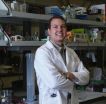Monkey see, monkey do: Visual feedback is necessary for imitating facial expressions
2012-12-28
(Press-News.org) Research using new technology shows that our ability to imitate facial expressions depends on learning that occurs through visual feedback.
Studies of the chameleon effect confirm what salespeople, tricksters, and Lotharios have long known: Imitating another person's postures and expressions is an important social lubricant.
But how do we learn to imitate with any accuracy when we can't see our own facial expressions and we can't feel the facial expressions of others?
Richard Cook of City University London, Alan Johnston of University College London, and Cecilia Heyes of the University of Oxford investigate possible mechanisms underlying our ability to imitate in two studies published in Psychological Science, a journal of the Association for Psychological Science.
In the first experiment, the researchers videotaped participants as they recited jokes and then asked them to imitate four randomly selected facial expressions from their videos. When they achieved what they perceived to be the target expression, the participants recorded the attempt with the click of a computer mouse.
A computer program evaluated the accuracy of participants' imitation attempts against a map of the target expression. In contrast to previous studies that relied on subjective assessments, this new technology allowed for automated and objective measurement of imitative accuracy.
In one experiment, the researchers found that participants who were able to see their imitation attempts through visual feedback improved over successive attempts. But participants who had to rely solely on proprioception – sensing the relative position of their facial features – got progressively worse.
These results are consistent with the associative sequence-learning model, which holds that our ability to imitate accurately depends on learned associations between what we see (in the mirror or through feedback from others) and what we feel.
Cook and colleagues conclude that contingent visual feedback may be a useful component of rehabilitation and skill-training programs that are designed to improve individuals' ability to imitate facial gestures.
###
For more information about this study, please contact: Richard Cook at Richard.Cook.1@city.ac.uk.
The APS journal Psychological Science is the highest ranked empirical journal in psychology. For a copy of the article "Facial Self-Imitation: Objective Measurement Reveals No Improvement Without Visual Feedback" and access to other Psychological Science research findings, please contact Anna Mikulak at 202-293-9300 or amikulak@psychologicalscience.org.
END
ELSE PRESS RELEASES FROM THIS DATE:
2012-12-28
One approach to understanding components in living organisms is to attempt to create them artificially, using principles of chemistry, engineering and genetics. A suite of powerful techniques—collectively referred to as synthetic biology—have been used to produce self-replicating molecules, artificial pathways in living systems and organisms bearing synthetic genomes.
In a new twist, John Chaput, a researcher at Arizona State University's Biodesign Institute and colleagues at the Department of Pharmacology, Midwestern University, Glendale, AZ have fabricated an artificial ...
2012-12-28
PHILADELPHIA - Calpain, a calcium-regulated enzyme, is essential to a host of cellular processes, but can cause severe problems in its overactivated state. It has been implicated as a factor in muscular dystrophy, AIDS, Alzheimer's disease, multiple sclerosis, and cancer. As such, finding and exploiting calpain inhibitors is an important area of research.
A team from the Perelman School of Medicine, University of Pennsylvania, in collaboration with the University of California at San Francisco and the Department of Biochemistry and Protein Function Discovery at Queen's ...
2012-12-28
Nashville (Tenn.) - The decision by several states not to expand Medicaid health insurance for the poor may create unintended cuts for hospitals that provide uncompensated care, according to a study by John Graves, Ph.D., a Vanderbilt policy expert in the Department of Preventive Medicine.
Graves used financial data from U.S. hospitals and insurance data in each state to predict cuts in Medicare and Medicaid disproportionate share (DSH) funds paid to the nearly three-fourths of U.S. hospitals that serve low-income patients. The results, published in the Dec. 20 issue ...
2012-12-28
PHILADELPHIA - One of the world's most devastating diseases is malaria, responsible for at least a million deaths annually, despite global efforts to combat it. Researchers from the Perelman School of Medicine at the University of Pennsylvania, working with collaborators from Drexel University, The Children's Hospital of Philadelphia, and Johns Hopkins University, have identified a protein in human blood platelets that points to a powerful new weapon against the disease. Their work was published in this months' issue of Cell Host and Microbe.
Malaria is caused by parasitic ...
2012-12-28
Researchers from the University of Vigo, in collaboration with the Environmental Services Unit at the Alejandro de Humboldt National Park (Cuba), have discovered two new species of Caribbean orchid.
The Caribbean islands have been natural laboratories and a source of inspiration for biologists for over two centuries now. Suffice to say that the studies by Charles Darwin and Alfred Russel Wallace in the tropical archipelagos contributed to the emergence of the theory of evolution.
In this case, a Spanish research team from the University of Vigo has discovered two new ...
2012-12-28
UC Davis Health System is improving lives and transforming health care by providing excellent patient care, conducting groundbreaking research, fostering innovative, interprofessional education, and creating dynamic, productive partnerships with the community. The academic health system includes one of the country's best medical schools, a 619-bed acute-care teaching hospital, a 1000-member physician's practice group and the new Betty Irene Moore School of Nursing. It is home to a National Cancer Institute-designated comprehensive cancer center, an international neurodevelopmental ...
2012-12-28
AURORA, Colo. (Dec. 27, 2012) – Researchers at the University of Colorado School of Medicine have figured out intimate details of how the hepatitis C virus takes over an invaded cell, a breakthrough that could point to way for new treatments for the virus.
Hep C hijacks the machinery by which a cell makes proteins and uses it instead to create proteins for the virus. Over the last two decades, researchers have figured out that Hep C uses an RNA molecule to do this. Now they're trying to fill in the details.
One key detail is reported in a paper published online Dec. ...
2012-12-28
(CHICAGO)--Researchers at Rush University Medical Center, in collaboration with researchers at Northwestern University, have identified a molecular mechanism central to the development of osteoarthritis (OA) pain, a finding that could have major implications for future treatment of this often-debilitating condition.
"Clinically, scientists have focused on trying to understand how cartilage and joints degenerate in osteoarthritis. But no one knows why it hurts," said Dr. Anne-Marie Malfait, associate professor of biochemistry and of internal medicine at Rush, who led ...
2012-12-28
Australian scientists have shown how a 'transcription factor' causes breast cancer to develop an aggressive subtype that lacks sensitivity to oestrogen and does not respond to anti-oestrogen therapies such as Tamoxifen and aromatase inhibitors.
Transcription factors are molecules that switch genes on or off. In this case, the transcription factor known as 'ELF5' inhibits sensitivity to oestrogen very early in the life of a breast cancer cell.
In 2008, Associate Professor Chris Ormandy from Sydney's Garvan Institute of Medical Research showed that ELF5 was responsible ...
2012-12-28
Lisa brings a lifetime of experience reading well over 20,000 hands from around the globe. Her readings include iconic film stars, rock stars, international CEO's, television personalities and people just like you. Lisa has an unparalleled history in Hand Analysis that brings a rich, deep understanding of human nature reflected in the lines on hand. Her latest e-book called "Relationship Rescue using CPR," teaches what your map of original programming is, and how to go beyond any conflicts.
Lisa Greenfield is the founder and CEO of TruthinHand.com. Her business ...
LAST 30 PRESS RELEASES:
[Press-News.org] Monkey see, monkey do: Visual feedback is necessary for imitating facial expressions



